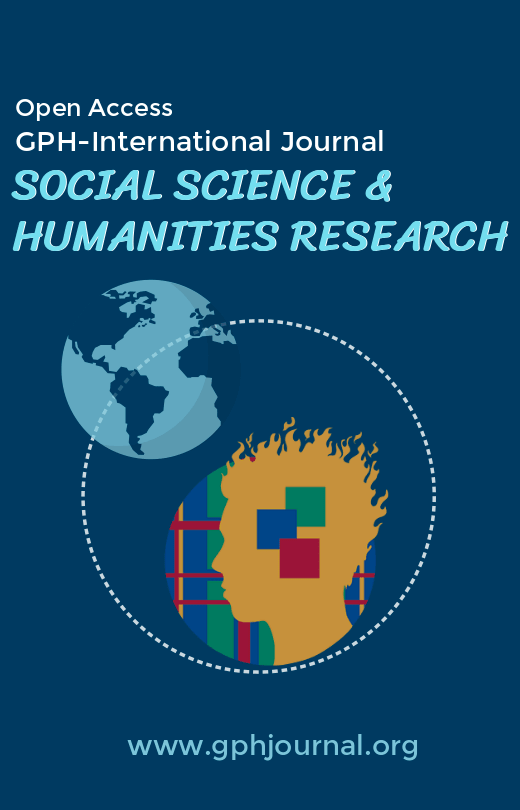Corruption Perception Index (CPI) and Government Expenditure in Sub Saharan Africa: The influence of Information Communication Technology (ICT)
Abstract
This study introduces the moderating effects of Information Communication Technology (ICT) in the relationship between corruption perception and government expenditures in Sub Saharan Africa. Two hypotheses were developed to address the research objectives. Data were collected from secondary sources and analysed with regression model through Eview package. The results of the study shows that corruption perception index (CPI) and Mobile cellular Telephone subscription (MCTS) are positive and significantly related with general government final capital expenditure. Even though corruption perception index and fixed telephone subscription (CPI*FTS) and CPI*MCTS are positive, they are both insignificant, however, fixed telephone subscription declines final consumption expenditure. The result also shows that one can be misled when thinking that corruption perception index influences the degree at which the government makes expenditures on final consumption.
Downloads
References
Aliyu, M., Zainab, S.S. & Lawal, W. O. (2017).Relationship between corruption and transmission mechanism.International Journal of Advanced Studies in Economics and Public Sector Management, 5(2), 140-189.
Anderson, T.W., & Hsiao, C. (1982). Formulation and estimation of dynamic models using panel data.Journal of Econometrics, 18 (1), 47-82.
Arellano, M.,& Bond, S. (1991). Some tests of specification for panel data: Monte Carlo evidence and an application to employment equations. The review of economic studies, 58 (2), 277-297.
Assiamah, E.Y., Asamoah, K., &Osei-kojo, A. (2014). Corruption here, corruption there, and corruption everywhere: a framework for understanding and addressing public sector corruption in developing African democracies. Journal of Public Administration and Governance, 4(3), 186-204.
Asongu, S.A. (2013). Fighting corruption in Africa: do existing corruption-control levels matter? International Journal of Development, 12(1), 36-52.
Awojobi, O.N. (2014). Corruption and underdevelopment in Africa: a discourse approach. International Journal of Economics, Commerce and Management, 11(10), 1-14.
Ayee, J.A. (2016). The roots of corruption: the Ghanaian enquiry revisited. Monograph of Institute of Economic Affairs (IEA), Ghana, No. 34.
Retrieved from: https://www.africaportal.org/publications/the-roots-of-corruption-the-ghanaian-enquiry-revisited/
Bailard, C.S. (2009). Mobile phone diffusion and corruption in Africa.Political Communication, 26(3), 333-353.
Bayart, J.F., Ellis, S. &Hibou, B., (1999). “From kleptocracy to the felonious state”in J.F. Bayart, S. Ellis & B. Hibou, The criminalization of the state in Africa, pp. 1−31, James Currey, Oxford.
Boyo, H. (2019). Nigeria, P&ID and $9.6b judgment fine: a postscript. Retrieved from: https://punchng.com/nigeria-pid-and-9-6bn-judgement-fine-a-postscript/
Brooks, C. (2008). Introductory econometrics for finance. Cambridge university press.
Caiden, G.E. &Caiden, Naomi (1994). Administrative corruption revisited. Philippine Journal of Public Administration, Vol. XXXVIII, No. 1, 1-17.
Chang, T., Liu, W., & Caudill, S. (2004).A re-examination of Wagner’s Law for ten countries based on co-integration and error correction modeling techniques. Applied Financial Economics, 14(8), 577–589.
Chene, M.(2008). Overview of corruption in Rwanda.Retrieved from: https://www.u4.no/publications/overview-of-corruption-in-rwanda.pdf
Cheme, M. (2009). Overview of corruption in Uganda. Retrieved from:
https://www.u4.no/publications/overview-of-corruption-in-uganda.pdf
Chene M. (2010). Overview of corruption and anti-corruption in Angola.Retrieved from:
https://www.u4.no/publications/overview-of-corruption-and-anti-corruption-in-angola.pdf
Chinedu, U. A., Daniel, O. C., &Ezekwe, U. C. (2018).Sectoral spreads of government expenditures and economic growth in Nigeria (1980-2017): an approach of error correction model. International Journal of Academic Research in Economics and Management Sciences,7(4), 180–195.
Choo, F., & Tan, K. (2007).An American dream theory of corporate executive fraud, Accounting Forum,31(2) 203-215.
International Telecommunication Union (2019). Country ICT data (until 2018).Retrieved from:
https://www.itu.int/en/ITU-D/Statistics/Pages/stat/default.aspx
IMF (2018).Cameroon: selected issues.
Retrieved from: https://www.imf.org/~/media/Files/Publications/CR/2018/cr18256.ashx
IMF (2020).Kenya fiscal transparency evaluation update.IMF Country Report No.20/2. Retrieved from:
https://www.google.co.uk/search?q=kenya+public+expenditure+review+2019&ei=4AO2Xvq-BYuxUKHAk4AI&start=10&sa=N&ved=2ahUKEwj6roilzaXpAhWLGBQKHSHgB IAQ8NMDegQIDBA_&biw=1016&bih=628
Jahnke, B. &Weisser, R.A. (2019). How does petty corruption affect tax morale in Sub-Saharan Africa? European Journal of Political Economy, 60(2019), 1-17.
Jajkowicz, O., &Drobiszova, A. (2015).The effect of corruption on government expenditure allocation in OECD countries.ActaUniversitatisAgriculturaeet Silviculturae MendelianaeBrunensis, 63(4): 1251–1259.
Jelilov, G and Musa, M. (2016). Impact of government expenditure on economic growth in Nigeria.Sacha Journal of policy and Strategic Studies, 5(1), 15-23.
Kasaija, M. (2018). Industrialization for job creation and shared prosperity: Uganda budget speech for fiscal year 2018/19. Retrieved from:
https://finance.go.ug/sites/default/files/Publications/Government%20of%20Uganda%20Budget%20Speech%20for%20Fiscal%20Year%202018-2019_1.pdf
Kassem, R., &Higson, A. (2012). The new fraud triangle model.Journal of Emerging Trends in Economics and Management Sciences, 3(3), 191-195.
Khan, F. &Pillay, P. (2019). Corruption and its repercussions on employment, poverty and inequality: Rwanda and South Africa Compared. Journal of Reviews on Global Economics, 2019(8), 1203-1212.
Kranacher M., Riley R.A., & Wells J.T (2011), Forensic Accounting and Fraud Examination, Wiley.
Kossow, N. & Dykes, V. (2018). Embracing digitization: how to use ICT to strengthen anti-corruption. Retrieved from: https://www.giz.de/de/downloads/giz2018-eng_ICT-to-strengthen-Anti-Corruption.pdf
Kotlanova, E.&Kotlan, I. (2012). Vlivinstitucionálníhoprostředínavelikostkorupce: Empirickáanalýza. PolitickáEkonomie, 2: 167–186.

Copyright (c) 2021 IJSSHR - International Journal of Social Science and Humanities Research

This work is licensed under a Creative Commons Attribution-NonCommercial-NoDerivatives 4.0 International License.
Author(s) and co-author(s) jointly and severally represent and warrant that the Article is original with the author(s) and does not infringe any copyright or violate any other right of any third parties, and that the Article has not been published elsewhere. Author(s) agree to the terms that the GPH Journal will have the full right to remove the published article on any misconduct found in the published article.




























